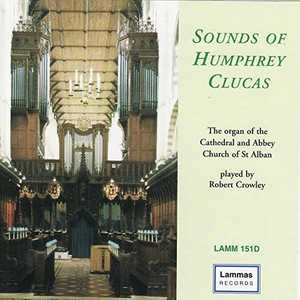Sounds of Humphrey Clucas

Robert Crowley plays the organ of the Cathedral and Abbey Church of St Albans
Suite
Prelude (Christe, Qui Lux Es)
Impromptu (Tonus Peregrinus)
Nocturne (Rorate Coeli)
Scherzo (Dies Irae)
Variations (Veni Creator)
Passacaglia
Sinfonietta
Prelude (Tantum Ergo)
Chorale (Soll’s Sein)
Toccata (Suo-Gn)
Credo
Adoro Te
Three Plainsong Preludes
Conditor Alme
Pange Lingua
Te Lucis Ante Terminum
Qui Lux Es
Total playing time 66m 08s
Sounds of Humphrey Clucas
Humphrey Clucas
Humphrey Clucas was born in 1941, and read English at King’s College, Cambridge, where he was a choral scholar. Having taught English in schools for twenty-seven years, while maintaining a separate singing career, he finally gave up teaching on his appointment as a Lay Vicar (member of the choir) of Westminster Abbey, from which he retired in 1999.
As a composer he is self-taught, and though he is well known for a set of Responses, written as an undergraduate, nearly all his serious work has been done in the last twenty-five years. He has written a great deal of choral music, much of it liturgical; between May and December, 2000, for instance, he wrote settings of the Evening Canticles for Westminster Abbey and for Ripon and Southwark Cathedrals, and a morning canticle (the Benedictus) for Guildford. But there are also concert works for unaccompanied choir (including a Requiem), a Housman song-cycle for counter-tenor, a Clarinet Sonatina published by Lengnick, and a growing series of pieces for double bass.
A CD of four large choral works was issued in 1994, and a second choral CD, Crufixus (1998), has been played both on Radio Three and on Classic FM. The current CD presents the best of his considerable output for organ.
Passacaglia and Three Plainsong Preludes are published by Oecumuse.
Robert Crowley
Robert Crowley is currently Director of Music and Chapel Organist at St George's School, Harpenden. He received his early musical training with Martin Neary as a chorister at St Margaret's Church, Westminster and he studied the organ with Martindale Sidwell at the Royal Academy of Music and subsequently with Susi Jeans and Arthur Wills. At the RAM he was awarded the Recital Diploma for Organ, also winning the Henry Richards and Frederick Keene Organ Prizes. He is particularly interested in contemporary music, and has commissioned pieces from a number of composers.
The organ at St Albans Cathedral
The organ at St Albans Cathedral has become famous throughout the world due to the St Albans International Organ Festival, founded by Peter Hurford in 1963. The Cathedral organ was rebuilt by Harrison and Harrison in 1962 to a design by Ralph Downes (Organist at Brompton Oratory), working in close collaboration with Peter Hurford (Master of the Music at St Albans Cathedral from 1958 to 1978). The organ is a particularly versatile instrument, capable of reflecting all schools of organ composition, providing the daily accompaniment for the Cathedral Choirs, leading and accompanying congregational singing and being at the centre of the International Organ Festival competitions and concerts.
Early records tell us that an organ was situated in the Chapel of St Mary in 1380, and that an Organist named Adam was in post in 1302, when John de Maryns was elected Abbot. The distinguished composer Robert Fayrfax was Organist at St Albans Abbey from c1498 to 1502, but records are sketchy until 1820, when Thomas Fowler was appointed. No mention is made of an organ in an inventory dated 1 November 1552, and there is no record of an organ until 1820, when an instrument by Father Smith and John Byfield, originally built by Father Smith for St Dunstan’s in the East in 1670, was installed.
A new organ was built in 1861 by William Hill, including the Father Smith Open Diapason from tenor C. The Abbey Church became the Cathedral of the new Diocese of St Albans in 1877, and in 1908 the organ was rebuilt with new oak cases (still in use today) by the firm of Abbott and Smith of Leeds. The organ was subsequently remodelled by Henry Willis and Son in 1929. It was decided however in 1958 that the instrument should be completely rebuilt, this time by Harrison and Harrison of Durham. Between 1959 and 1962 services were accompanied by a two-manual organ with 13 speaking stops, placed on the centre of the nave screen. The rebuilt organ was dedicated by the Bishop of St Albans on 18 November 1962.
The organ has been modified a little in recent years. In 1972 the nave of the Cathedral was reordered in response to changing liturgical needs, and at this time the manual mixtures were slightly raised in pitch and the console was moved to the centre of the organ loft with the organist facing west. In 1991 the Swell Cymbel was replaced by a three-rank Mixture designed by Mark Venning and Peter Hopps of Harrison and Harrison.
Recorded in the Cathedral and Abbey Church of St Alban on 9 October and 13 November 2002 by kind permission of Andrew Lucas (Master of the Music) and the Dean and Chapter.
Produced by Humphrey Clucas
Recorded and edited by Lance Andrews
Photograph by Lance Andrews